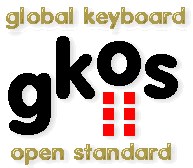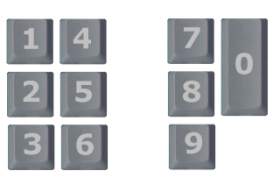Basically, GKOS is a chording (or chordic) keyboard (see the comparison!) but as the keypad is split between two hands, the number of different combinations of simultaneous key presses per hand is very low. Unlike most chording keyboards, GKOS was designed especially for integration in cellular devices.
The GKOS Keyboard Features
Because the key combinations are extremely simple most of the time (just pressing single keys or two adjacent keys by one hand) no special physical skill is required. The most difficult combinations are rare and they are like pressing Ctrl+Alt+Del on your PC QWERTY keyboard. You can do that for sure!.
You can think that letters and numbers are single keys, often requiring a 2-key shift function to be pressed by the other hand. In addition, the shifts are letters as well when pressed alone (G, K, O, S, W).
Using the keyboard (for typing) involves both hands, as is also the case e.g. with PDAs having stylus interface or QWERTY. This could be seen as one disadvantage of the GKOS. There is also a learning curve as this is a completely new method of typing, but...
...the list of advantages, however, is long (35 items):
1. The keyboard takes up no space on the front panel or on the display area.
2. Low cost and easy to integrate on a small device (few keys, easy to find place for).
3. The same hardware suits most languages (simplifies production)
4. Simple enough for the beginner (on-screen help for immediate start).
5. Suitable for fast typing (experienced user: 30-45 wpm, expert: 45-60 wpm)
6. Does not require full attention of the typist (no eye stress due to watching a character list etc.).
7. Usable also in the dark or with eyes closed (impaired vision also allowed).
8. There is no need to have backlight on the 6 buttons (lower power consumption)
9. In addition to text entry, includes all functions of the PC QWERTY keyboard.
10. Can be used to control all functions of a modern camera phone (example).
11. Operates as a game control (or even as a pointer control in some cases).
12. Provides dialling functions. Calls can be made using one hand only (example).
13. Facilitates display browsing and menu selection (no extra buttons or wheels required).
14. No desk needed: can be used while standing, lying down, walkinq etc.
15. Fully integrated and does not require separate tools (no stylus or alike).
16. Seamlessly combines with a mouse or other pointing device (thumbs can be used).
17. Also usable as a remote PC keyboard etc. if desired (by those preferring the new method).
18. No special physical skills needed (Required skill range: 'press J' to 'press Ctrl+Alt+Del' on QWERTY).
19. Treats left and right-handed people equally (physically symmetric).
20. GKOS typing skill does not interfere with QWERTY typing skill (quite different, not to be mixed up).
21. Does not necessarily increase the physical size of the mobile phone/terminal.
22. A stand-alone GKOS keyboard can be extremely small (matchbox, pen; thin/solid; flips into pocket)
23. Can be combined with the conventional dialling pad (keys 1, 2 and 3 are then common) if desired.
24. Can also be used on a desk (see the SixBack implementation as an example)
25. The same virtual keyboard (partly shown below), if visible on the screen, can be used either by a stylus/pen or on the GKOS keys on the back of the same device.
26. Can be integrated on a QWERTY keyboard (using SDF/JKL keys for GKOS entry).
27. Room for national characters reserved on an equal basis compared to just A to Z.
28. No need to attach the device to the user (no belt, hand strap or alike required)
29. No need to optimise the size and form of the keyboard for the hand of an individual user.
30. Supports hundreds of (more than 700) word shortcuts (type complete words by just one or two key presses)
31. Device is not visually too peculiar (it is hard to notice the keys; comfortable in public; you will not look too 'nerdy').
32. Use of the keyboard is discreet (no special preparations, clothes/gloves, glasses, gestures, sounds or alike).
33. Provides tactical feedback (you can feel the operation of the keys).
34. Unambiguous: even invented new words can be typed immediately without any limitation in speed.
35. Open standard, free for anyone to use for any purpose (but keep the character set harmonised!).
...
(You can use the list above to make comparisons between GKOS and other text entry methods. Try it!)

Fig. Virtual GKOS keyboard that can be used for typing on the six keys on the back of the device (GKOS Alphabetical Layout).FIN/SWE version of a virtual keyboard (Alphabetical Layout) >>
Optimised GKOS Letter Frequency Layouts on a Touch screen >>


